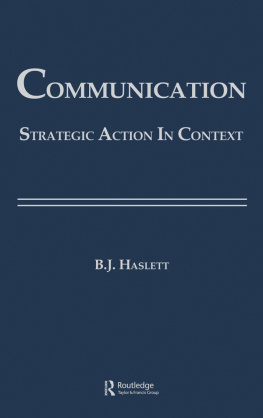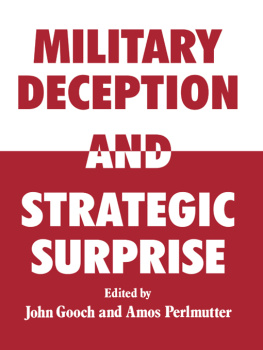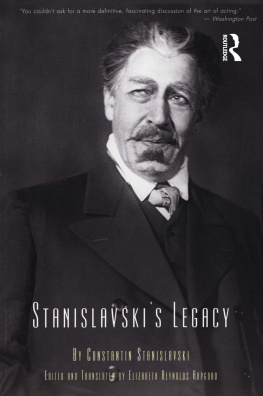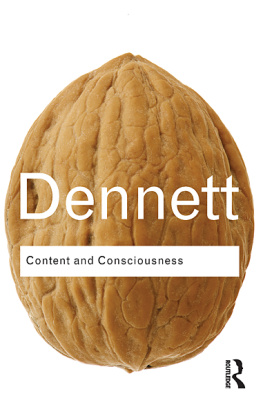Haslett - Communication : Strategic Action in Context.
Here you can read online Haslett - Communication : Strategic Action in Context. full text of the book (entire story) in english for free. Download pdf and epub, get meaning, cover and reviews about this ebook. City: Hoboken, year: 2013, publisher: Taylor and Francis, genre: Home and family. Description of the work, (preface) as well as reviews are available. Best literature library LitArk.com created for fans of good reading and offers a wide selection of genres:
Romance novel
Science fiction
Adventure
Detective
Science
History
Home and family
Prose
Art
Politics
Computer
Non-fiction
Religion
Business
Children
Humor
Choose a favorite category and find really read worthwhile books. Enjoy immersion in the world of imagination, feel the emotions of the characters or learn something new for yourself, make an fascinating discovery.
- Book:Communication : Strategic Action in Context.
- Author:
- Publisher:Taylor and Francis
- Genre:
- Year:2013
- City:Hoboken
- Rating:3 / 5
- Favourites:Add to favourites
- Your mark:
- 60
- 1
- 2
- 3
- 4
- 5
Communication : Strategic Action in Context.: summary, description and annotation
We offer to read an annotation, description, summary or preface (depends on what the author of the book "Communication : Strategic Action in Context." wrote himself). If you haven't found the necessary information about the book — write in the comments, we will try to find it.
Haslett: author's other books
Who wrote Communication : Strategic Action in Context.? Find out the surname, the name of the author of the book and a list of all author's works by series.
Communication : Strategic Action in Context. — read online for free the complete book (whole text) full work
Below is the text of the book, divided by pages. System saving the place of the last page read, allows you to conveniently read the book "Communication : Strategic Action in Context." online for free, without having to search again every time where you left off. Put a bookmark, and you can go to the page where you finished reading at any time.
Font size:
Interval:
Bookmark:
COMMUNICATION:
S trategic A ction in C ontext
COMMUNICATION
A series of volumes edited by:
Dolf Zillmann and Jennings Bryant
ZILLMANN and BRYANT Selective Exposure to Communication
BEVILLE Audience Ratings: Radio, Television, and Cable
BRYANT and ZILLMANN Perspectives on Media Effects
GOLDSTEIN Reporting Science: The Case of Aggression
ELLIS and DONOHUE Contemporary Issues in Language and Discourse Processes
WINETT Information and Behavior: Systems of Influence
HUESMANN and ERON Television and the Aggressive Child: A Cross-National Comparison
GUNTER Poor Reception: Miscomprehension and Forgetting of Broadcast News
RODDA and GROVE Language, Cognition, and Deafness
HASLETT Communication: Strategic Action in Context
DONOHEW, SYPHER, and HIGGINS Communication, Social Cognition, and Affect
Olasky Corporate Public Relations and Private Enterprise: A New Historical Perspective
Beth Haslett
University of Delaware
COMMUNICATION:
S trategic A ction in C ontext

Copyright 1987 by Lawrence Erlbaum Associates, Inc.
All rights reserved. No part of this book may be reproduced in any form, by photostat, microform, retrieval system, or any other means, without the prior written permission of the publisher.
First published by Lawrence Erlbaum Associates, Inc., Publishers
10 Industrial Avenue
Mahwah, New Jersey 07430
Reprinted 2008 by Routledge
Routledge
270 Madison Avenue
New York, NY 10016
2 Park Square, Milton Park
Abingdon, Oxon OX14 4RN, UK
Library of Congress Cataloging in Publication Data
Haslett, Beth.
Communication, strategic action in context.
(Communication)
Bibliography: p.
Includes indexes.
1. Communication. 2. Pragmatics. I. Title. II. Series: Communication (Hillsdale, N.J.)
P91.H375 1987 401.9 86-32806
ISBN 0-89859-871-0
To My Parents,
Clifford W. Bonniwell and Edna Stoeckmann Bonniwell and My Family,
David, Heidi and Erik
This book attempts to outline a descriptively adequate basis for the study of human communication. It does so by advocating a pragmatic approach to communication, an approach based on the study of language use in context. This approach provides a basis for integrating the study of verbal communication across diverse settings, tasks, and participants. In addition, this approach may provide a basis for studying nonverbal communication as well because many scholars suggest that nonverbal communication is organized like verbal communication and that both communicative systems complement one another. A pragmatic approach thus offers a perspective through which an integrated study of human communication processes is possible. However, pragmatics, as an approach to the study of human communication, is distinct from pragmatics as a sub-area of linguistics.
As such, this book is broad in its scope and goals. It covers work on verbal communication in many disciplines, and represents a variety of underlying assumptions and methods of analysis. However, as I argue in , important common assumptions underlie research on pragmatics and it is this convergence, I believe, that offers the promise for an integrated study of human communication.
A promising convergence is also occurring within the social sciences. The convergence of concepts, assumptions, and methods from multiple disciplines is an exciting intellectual phenomenon. Some of this convergence is due to a sense of crisis in the social sciences; increasing attention is being given to basic reformulations concerning the nature of knowledge itself and concerning the conduct of social science research (Foucault, 1972; Giddens, 1976, 1979, 1982; Kuhn, 1970). Increasingly, scholars are calling for integration of research findings in communication (M. Atkinson, 1981; Duck, 1980; Hinde, 1981) and for the use of multiple methods of analysis.
The possibility of an integrated pragmatic approach to analyze communication, supported by models of social science research emphasizing such integrated approaches, provides strong intellectual support for the synthesis attempted here. The very structure of the book itself is an argument about how communication should be studied: the topics included, and their organization and integration in this book, are meant as a statement about how communicative processes take place.
I have, in some cases, reframed and extended others research to show how their work fits into the analysis of human communication. In all instances, I have tried to remain faithful to the original formulations intended by these scholars. However, I may use their research in ways unintended by them, yet compatible with their original formulations. For example, the work on speech markers has been done primarily in the context of intergroup communication. I have, however, viewed speech markers here as accountability practicesa view, insofar as I can determine, not intended by any of the scholars researching speech markers, but certainly compatible with their views on intergroup communication processes. In addition, this book blends both European and North American scholarship. As such, I hope it will direct readers to additional sources of information, and contribute to the cross-disciplinary sharing of ideas.
The book is divided into three sections. The first section outlines the major approaches to pragmaticsthe structural, functional, and contextual approaches. The next section synthesizes these approaches into an integrated, descriptively adequate basis for the study of human communication. Finally, the third section deals with pragmatic research in the major contexts in which communicative skills are acquired the developmental environment during the first 5 years; the context of interpersonal relationships, and educational settings. Each chapter in this section represents a coherent view of communication research in those areas, although obviously not an exhaustive view.
Each chapter can be read independently and thus stands alone. However, I believe readers will benefit from reading the chapters in the order they are presented. Each chapter leads logically into subsequent chapters and thus contributes to an overall sense of how communication should be analyzed.
Through this book, I wish to present a general view of how verbal communication works and to describe significant influences on communicative processes. At this level of analysis, for example, I want to demonstrate the richness and complexity of contextual influences on communication rather than articulate a fully worked-out model of how a particular aspect of context influences communication. In so doing, and in view of the books scope, comprehensive discussion of every approach has not been possible. Important distinctions among the various approaches that are not critical to the level of analysis undertaken here are not discussed. Briefly put, I am focusing on the underlying themes that permit an overall, integrated pragmatic approach to emergenot on important (yet, from my view, not critical) distinctions among approaches.
Both broadly focused and narrowly focused analyses of communication are needed: I have chosen to do the former, while many scholars choose to do the latter. I believe there is an imbalance between these two alternatives; too much attention has been directed at fully developing views on a particular aspect of communication, and not enough attention paid to how various aspects of communication fit together in the process of humans communicating. I am certainly not suggesting here that we abandon more detailed analyses of specific features of communication, but merely that we place those efforts in the context of a more comprehensive view of communication. Most especially, as I argue in , we need to examine relevant, previously unexplored interrelationships among communicative features.
Font size:
Interval:
Bookmark:
Similar books «Communication : Strategic Action in Context.»
Look at similar books to Communication : Strategic Action in Context.. We have selected literature similar in name and meaning in the hope of providing readers with more options to find new, interesting, not yet read works.
Discussion, reviews of the book Communication : Strategic Action in Context. and just readers' own opinions. Leave your comments, write what you think about the work, its meaning or the main characters. Specify what exactly you liked and what you didn't like, and why you think so.







